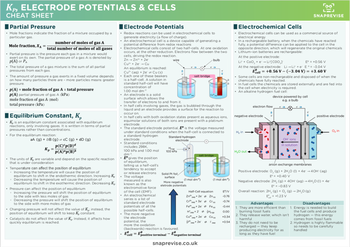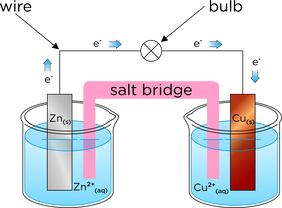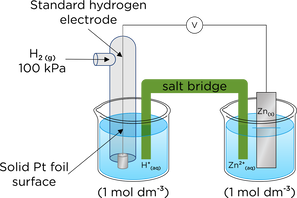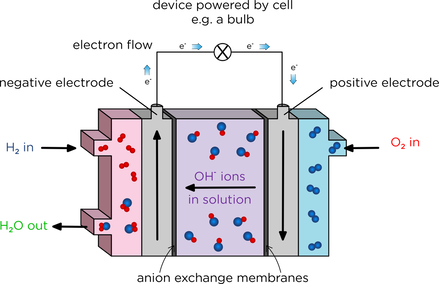A-LEVEL AQA ChEMISTRY NOTES
Electrode Potentials and Electrochemicals
Electrode Potentials
- Redox reactions can be used in electrochemical cells to generate electricity (a flow of charge).
- An electrochemical cell is a device capable of generating a potential difference from redox reactions
- Electrochemical cells consist of two half-cells. At one oxidation occurs, at the other reduction. Electrons flow between the two cells, driving the redox reaction.
Zn → Zn^2+ + 2e^-
Cu^2+ + 2e^- → Cu
Cu^2+ + 2e^- → Cu
An equilibrium is reached: Cu^2+(aq) + 2e^- ⇌ Cu (s)
- Each one of these beakers is a half-cell. A solution in a standard half-cell will have a concentration of 1.00 mol dm^-3
- An electrode is a solid surface which allows the transfer of electrons to and from it.
- In half cells involving gases, the gas is bubbled through the liquid and an electrode provides a surface for the reaction to occur on.
- In half cells with both oxidation states present as aqueous ions, equimolar solutions of both ions are present with a platinum electrode.
- The standard electrode potential, E^⦵ is the voltage measured under standard conditions when the half-cell is connected to a standard hydrogen electrode.
- Standard conditions includes 298K, 100kPa and 1.00 mol dm^-3.
- E^⦵ gives the position of equilibrium, telling us a half-cell’s tendency to accept or release electrons
- The voltage measured is also known as the electromotive force of the cell (EMF).
- An electrochemical series is a list of standard electrode potentials of all the possible half-cells.
- The more negative the electrode potential, the more the oxidation (backwards) reaction is favoured.
- E^⦵cell = E^⦵positive terminal - E^⦵negative terminal
Electrochemical Cells
- Electrochemical cells can be used as a commercial source of electrical energy
- In a rechargeable battery, when the chemicals have reacted fully, a potential difference can be applied to the cell in the opposite direction, which will regenerate the original chemicals
- Lithium-ion batteries are rechargeable:
- Some cells are non-rechargeable and disposed of when the chemicals have fully reacted.
- In fuel cells the chemicals are stored externally and are fed into the cell when electricity is required.
- An alkaline hydrogen fuel cell:
Advantages |
Disadvantages |
1. They are more efficient than burning fossil fuels 2. They release water, which isn’t harmful 3. They do not need to be recharged – they keep producing electricity for as long as they have fuel |
1. Energy is needed to build the fuel cells and produce hydrogen – this energy comes from fossil fuels 2. Hydrogen is highly flammable so needs to be carefully handled |







